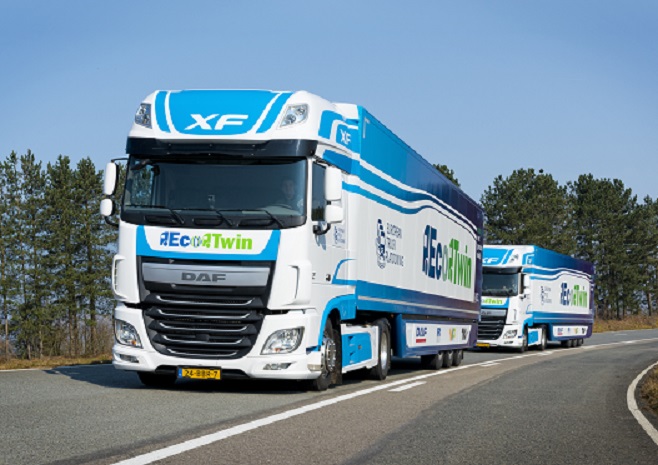
Eindhoven, Netherlands, NXP Semiconductors N.V. (NASDAQ: NXPI) and DAF Trucks successfully demonstrated self-driving technologies in automated trucks. The demonstration is part of the European Truck Platooning Challenge, an event organized by the Dutch Ministry of Infrastructure and the Environment, that has trucks driving in columns (platooning) on public roads from several European cities to the Netherlands. The challenge is designed to bring autonomous platooning one step closer to implementation by showcasing economic, traffic management and safety advantages. It also addresses the need for legislation and standardization of Intelligent Transportation Systems (ITS) across Europe, as current rules and regulations regarding speed and distance vary between countries.
Under the EcoTwin consortium, NXP, DAF, TNO and Ricardo joined forces to make this demonstration possible. The core of the ‘EcoTwin’ technology setup is a sophisticated vehicle-to-vehicle (V2V) communications solution, RoadLINK, developed by NXP. It uses the wireless communications standard IEEE802.11p combined with NXP radar technology to empower the trucks within the platoon to securely exchange information in real time and automatically brake and accelerate in response to the lead truck. The high speed of communication and responsiveness of NXP RoadLINK technology allows extremely tight distances and truly synchronous driving between the platooning DAF Trucks: To demonstrate autonomous acceleration and braking, the planned distance between the vehicles is slated for 0.5 seconds – which, when traveling at 80 kph (50 mph), approximates to a distance of only 10 metres (30 feet). The responsiveness of the trailing truck within the platoon is estimated at 25 times faster than the average human reaction time of one second – saving critical time in case of emergency braking.
The RoadLINK communication system designed by NXP is built into the mirrors of the DAF Trucks participating in the platoon. The redundant NXP V2V system design with four secure channels ensures extremely reliable communication. In addition to providing the platooning commands, it provides real time video and bi-directional audio communication between the two vehicles. The audio allows the drivers to talk to each other without relying on other communication channels, such as cellular networks. Furthermore, the V2V powered camera in the lead truck streams what it “sees” to the driver in the trailing truck, providing a clear look at the road ahead.
“We’re honored to be part of the European Truck Platooning Challenge as a key partner and provider of the secure vehicle-to-vehicle and radar technologies for the DAF trucks – DAF and other truck platoons will use our technology to complete their journey safely and effectively,” said Torsten Lehmann, senior vice president of Car Infotainment and Driver Assistance for NXP. “As a clear industry leader in driving adoption of Vehicle-to-X technologies, NXP is helping to improve fuel efficiency, emissions, safety, and traffic flow in the European Union, while avoiding accidents and saving lives.”
“It goes without saying that there is still a lot of continued development required before we can introduce platooning as a new technology on the market”, says Ron Borsboom, member of DAF Trucks' Board of Management and responsible for product development. “This is definitely not a process that will be complete before 2020. There is still a great deal that has to be sorted out in terms of legislation, liability and acceptance. In conjunction with NXP, TNO, and Ricardo, we will be demonstrating during the European Truck Platooning Challenge that truck platooning is technically possible. This demonstration should pave the way for truck manufacturers to be allowed to carry out further testing of the technology on public roads in order to acquire even more experience. It is now up to politicians to make this possible.”
NXP’s radar solutions and RoadLINK technology are used in several of the truck platoons set to participate in the April 6 event in the Netherlands. NXP’s vehicle-to-vehicle (V2V) and vehicle-to-infrastructure (V2I) technology is essential for the continued development and advancement of self-driving cars and macro-traffic management. It helps vehicles automatically exchange information on speed, position and direction with other automobiles in their vicinity and enables vehicles and infrastructure to communicate traffic management data or hazards such as localized speed limits, traffic signaling and road works warnings, hazardous locations and more. This can significantly improve traffic flow, decrease accidents and reduce fuel consumption and emissions. NXP is cooperating on V2X technologies with car OEMs and major industry players including Siemens, Harman, Delphi and Cohda Wireless. NXP’s RoadLINK will be implemented in series cars starting this year as part of the Delphi V2X platform. NXP is also a leading supplier of radar technologies for advanced driver assistance systems, with more than 15 million units shipped to date.
IEEE 802.11p is an approved amendment to the IEEE 802.11 standard to add wireless access in vehicular environments (WAVE), a vehicular communication system. It defines enhancements to 802.11 (Wi-Fi) required to support Intelligent Transportation Systems (ITS) applications.
IEEE 802.11p standard uses 10 MHz bandwidth channels in the 5.9 GHz band (5.850-5.925 GHz).
Advertisement
Learn more about NXP Semiconductors





